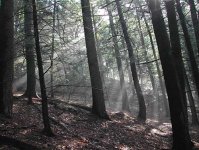I thought you meant there was something in the unassessed waters PowerPoint that indicated that the best of the brookie streams today are likely to have populations similar to what they were in the past.
It should be considered as an open question. Do the best brookie streams today have populations that are lower, higher, or about the same as in the past?
Suppose you took a slice of the best brookie streams today, let's say the top 5%. Would to total populations of those streams be lower or higher or about the same?
I think the populations of those streams would be lower, MUCH lower, than in the past.
I realize that doesn't sound intuitive. There is a common idea, which I've often heard and read, that the forests were cut over, the brookies suffered, but now the forests have regrown, so conditions have recovered to similar as before.
But I don't think that is the case. There are still many differences that impact the brookie populations in the best brookie streams.
But the most important factor is the physical habitat of the streams, particular the "holding water" for trout, i.e. pool habitat and overhead cover.
One of the reasons for this is that in forested floodplain streams, much of the pool formation comes from large woody debris, LWD. And LWD levels now are a small fraction of what they were historically.
The accumulated LWD was removed during the logging days, for splash damming. And though the forests have grown back, they are young to medium aged forests, so they produce much less large woody debris, both in numbers of downed trees and in the size of the fallen trees.
In places you can see where there is some good large woody debris, how it creates excellent pools and cover for the fish. A single big downed tree can transform a shallow featureless stretch into a pool that is waist deep, and also has good places to hide in under the tree. I've seen places where one fallen tree created TWO pools, one below the tree and another above.
In the pre-logging era, the forested floodplain streams would have been jumbled with downed trees and logjams. It would just be pool, riffle, pool the whole way up the creek. Such places exist in old growth forests in the west and Alaska.
Besides LWD, other remaining impacts include channels were straightened for splash damming and for building logging rr grades. And many of those remain straight today. Many channels were pinned, constrained, separated from the floodplains by logging rr grades. They cannot meander and form meander bend pools. LWD does not "stick" because the stream is a straight chute. Floodwaters are contained within the channel rather than going out across the flood, creating excessive scour.
There are also grade control issues caused by lack of LWD, and by channelization of streams further down, that extends up into the backcountry areas through nickpoint migration. That is why there are so many stretches running on flat bedrock. The streams have incised down to bedrock because of loss of grade control.
Another thing that is surprisingly common is stretches of stream that are still impacted today by "legacy sediment" on the floodplains left by old splash dams and sawmill dams. The sediment accumulated on the floodplains behind these dams, several feet thick. When the dams were removed or broke down, the streams cut down through that sediment. The physical habitat, particularly pools, is usually very poor in these stretches.
Then there are the gas line crossings, powerline cuts, ATVs riding through the streams.
And also harvest of trout. Even the backcountry streams get hit. Some more than others. But many of the streams in good condition (by todays standards) are known and people fish them and harvest fish.






